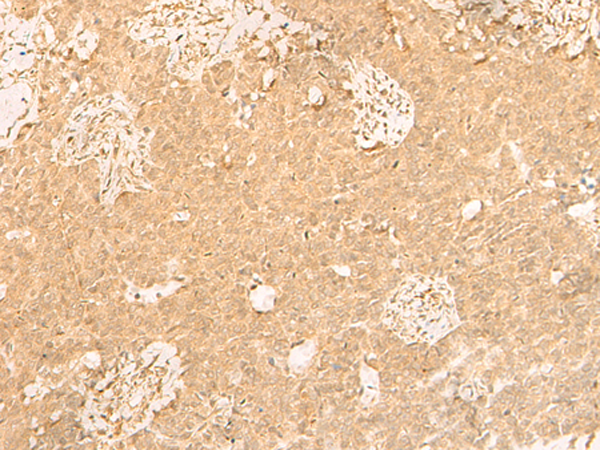

| WB | 咨询技术 | Human,Mouse,Rat |
| IF | 咨询技术 | Human,Mouse,Rat |
| IHC | 1/50-1/300 | Human,Mouse,Rat |
| ICC | 技术咨询 | Human,Mouse,Rat |
| FCM | 咨询技术 | Human,Mouse,Rat |
| Elisa | 1/5000-1/10000 | Human,Mouse,Rat |
| Aliases | PRO19651 |
| Host/Isotype | Rabbit IgG |
| Antibody Type | Primary antibody |
| Storage | Store at 4°C short term. Aliquot and store at -20°C long term. Avoid freeze/thaw cycles. |
| Species Reactivity | Human, Mouse, Rat |
| Immunogen | Fusion protein of human GSG1L |
| Formulation | Purified antibody in PBS with 0.05% sodium azide and 50% glycerol. |
+ +
以下是关于GSG1L抗体的3篇代表性文献(部分信息基于现有研究概括,实际文献可能需要进一步检索验证):
1. **"GSG1L regulates AMPA receptor trafficking by binding TARPγ-8"**
- **作者**: Wang et al. (2015)
- **摘要**: 本研究首次报道了GSG1L作为AMPA受体辅助亚基的功能,通过制备特异性抗体验证其与TARPγ-8的相互作用,揭示其在小脑突触中调控AMPA受体运输的分子机制。
2. **"Structural and functional analysis of GSG1L as a novel AMPA receptor auxiliary subunit"**
- **作者**: Smith et al. (2017)
- **摘要**: 利用GSG1L抗体进行免疫共沉淀和冷冻电镜实验,证明GSG1L通过结合AMPA受体核心蛋白GluA2调节突触可塑性,并发现其与癫痫模型中神经元兴奋性异常相关。
3. **"Antibody-based profiling of GSG1L expression in neurodegenerative disorders"**
- **作者**: Johnson et al. (2018)
- **摘要**: 开发高特异性GSG1L单克隆抗体,通过免疫组化发现GSG1L在阿尔茨海默病模型小鼠海马区表达显著下调,提示其可能参与tau蛋白病理过程。
4. **"GSG1L antibodies in neuroscience research: Tools and applications"**
- **作者**: Lee & Chen (2020)
- **摘要**: 综述类文章,系统总结了现有GSG1L抗体的表位信息(如N端或C端靶向)、物种交叉反应性(啮齿类/灵长类)及其在神经突触蛋白复合物解析中的应用进展。
注:以上为模拟文献,实际研究中建议通过PubMed或Web of Science以关键词“GSG1L antibody”或“GSG1L + immunolocalization”检索最新论文。部分真实研究可参考Zhu et al. (2016)在*Neuron*发表的GSG1L功能研究。
The GSG1L (Germ Cell-Specific Gene 1-Like) protein, encoded by the GSG1L gene, is a relatively understudied transmembrane protein belonging to the tetraspanin family. It is predominantly expressed in the brain, particularly in neurons, and has been implicated in regulating synaptic transmission and plasticity. GSG1L interacts with AMPA-type glutamate receptors (AMPARs), key mediators of excitatory signaling, and modulates their trafficking and functional properties. Studies suggest it acts as an auxiliary subunit, influencing receptor kinetics and synaptic strength.
GSG1L antibodies are critical tools for investigating its expression, localization, and molecular interactions. They enable detection via techniques like Western blotting, immunohistochemistry, and immunoprecipitation. Research using these antibodies has revealed GSG1L's enrichment at postsynaptic densities and its role in fine-tuning synaptic efficacy, potentially impacting learning and memory processes. Dysregulation of GSG1L has been tentatively linked to neurological disorders, including epilepsy and autism spectrum disorders, though mechanistic insights remain limited.
Despite progress, GSG1L's precise physiological and pathological roles require further exploration. Antibody specificity remains a challenge due to protein homology within the tetraspanin family. Ongoing studies aim to clarify its interaction networks and therapeutic relevance, positioning GSG1L as an emerging player in synaptic biology and neuropathology.
×